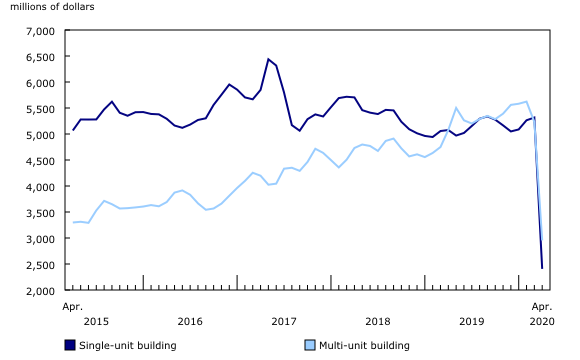Investment in building construction, April 2020
Archived Content
Information identified as archived is provided for reference, research or recordkeeping purposes. It is not subject to the Government of Canada Web Standards and has not been altered or updated since it was archived. Please "contact us" to request a format other than those available.
Released: 2020-06-22
$8.4 billion
April 2020
45.9% 
(monthly change)
Investment in building construction plunged 45.9% to $8.4 billion in April compared with the previous month. Previously, the largest national decline on record for the current series (which dates back to 2010) was a 3.9% decrease in August 2017.
Both the residential (-49.2%) and non-residential (-38.8%) sectors reported record declines. Investment decreased in all provinces and territories, with Ontario (-$3.2 billion) and Quebec (-$2.5 billion) reporting the largest declines.
Public health measures put in place to slow the spread of COVID-19 severely impacted the construction industry in April as the largest provinces in the country shut down all non-essential construction sites.
On a constant dollar basis (2012=100), investment in building construction decreased by 45.7% to $6.9 billion.
For more information on housing, please visit the Housing Statistics Portal.
Residential investment
All provinces and territories reported double-digit declines in residential investment for the month of April, with Quebec (-77.6% to $457 million) and Ontario (-46.8% to $2.4 billion) reporting the largest declines. In Quebec, all new residential construction sites remained closed through April 20, while in Ontario, all non-essential renovation construction was halted in accordance with public health requirements.
Declines in the residential sector varied by province, however, at a national level, the declines were felt more sharply in single family homes (-54.7%) than in multi-family dwellings (-43.5%).
Residential renovations largely ground to a halt across the country, with the exception of certain activities such as emergency and exterior repairs, as many projects were cancelled or deferred to comply with public health requirements.
On the other hand, new residential construction was able to progress across most of the country in April. Excluding Quebec, new residential construction increased 11.7% on an unadjusted basis compared with April 2019, as construction firms adapted to public health requirements such as improved on-site sanitation, physical distancing, and staggered work schedules.
Non-residential investment
Investment in the non-residential sector plummeted 38.8% to $3.0 billion in April compared with the previous month. During this time, non-residential construction was largely shut down in Ontario and Quebec, while other provinces and territories allowed work to continue with strict public health measures in place. As a result, five provinces—including Manitoba (+1.6%), Saskatchewan (+1.3%) and British Columbia (+0.9%)—posted modest gains for the sector. British Columbia's increase in April followed five consecutive monthly declines.
The commercial component posted the largest decline (-49.4%), with notable decreases in Ontario (-$905.3 million) and Quebec (-$522.8 million). Saskatchewan, Nova Scotia and British Columbia were the only provinces to post gains for this component.
The institutional component tumbled 22.2% (-$247.5 million), with the largest decline in Quebec (-$193.4 million). Conversely, modest gains were reported in British Columbia (+$3.8 million).
The industrial component decreased 25.3% to $664.4 million. Quebec (-92.8%) and Ontario (-18.7%) contributed the most to the decline, while four provinces reported small gains.
Note to readers
Based on the extraordinary events and business disruptions around COVID-19, Statistics Canada has made adjustments to the models used to estimate investment in building construction. As a result of these adjustments, there may be larger than normal revisions to the data in subsequent months.
Unadjusted data for the current reference month are subject to revision based on late responses. Data for the previous month have been revised. Deflated data and seasonally adjusted data are revised for the previous two months.
Data presented in this release are seasonally adjusted unless otherwise stated. Using seasonally adjusted data allows month-to-month comparisons by removing the effects of seasonal variations. For information on seasonal adjustment, see Seasonally adjusted data – Frequently asked questions.
Monthly estimates for constant dollars are calculated using quarterly deflators from the Building Construction Price Index (18-10-0135-01). Typically, the first two months of a quarter use the previous quarters' price level and are revised when the new quarterly price index becomes available.
Detailed data on investment activity by type of building and type of work are now available in the unadjusted current dollar series.
Prior to January 2018, building permits for cottages with a value greater than $60,000 were automatically reclassified to structure type Single. Beginning with January 2018, regardless of value, building permits received from municipalities coded as cottages remain classified as a cottage.
Effective November 23, 2018, table 34-10-0175-01 contains data on both the residential and non-residential sector. It replaced tables 34-10-0010-01, 34-10-0011-01 and 34-10-0012-01.
Products
Statistics Canada has a new Housing Market Indicators dashboard. This web application provides access to key housing market indicators for Canada, by province and by census metropolitan area. These indicators are automatically updated with new information from monthly releases, giving users access to the latest data.
Next release
Data on investment in building construction for May will be released on July 21.
Contact information
For more information, or to enquire about the concepts, methods or data quality of this release, contact us (toll-free 1-800-263-1136; 514-283-8300; STATCAN.infostats-infostats.STATCAN@canada.ca) or Media Relations (613-951-4636; STATCAN.mediahotline-ligneinfomedias.STATCAN@canada.ca).
- Date modified:





